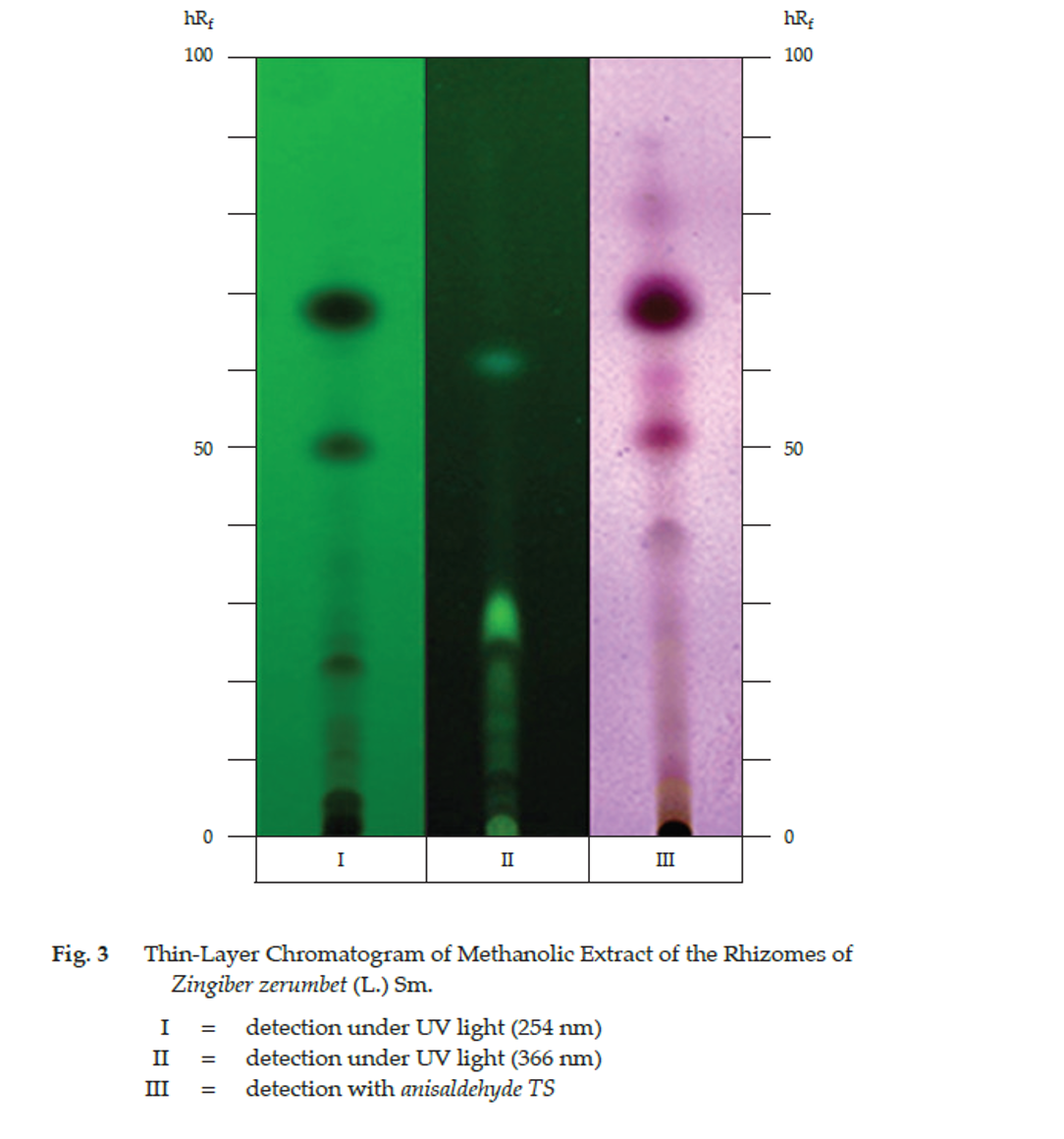ตำรามาตรฐานยาสมุนไพรไทย
Thai Herbal Pharmacopoeia
สำนักยาและวัตถุเสพติด กรมวิทยาศาสตร์การแพทย์ กระทรวงสาธารณสุข
Bureau of Drug and Narcotic, Department of Medical Sciences, Ministry of Public Health(Tinospora crispa (L.) Hook.f. & Thomson)
(Nelumbo nucifera Gaertn.)
(Centella asiatica (L.) Urb.)
(Centella Dry Extract)
(Centella Cream)
(Mesua ferrea L.)
(Piper sarmentosum Roxb.)
(Piper sarmentosum Roxb.)
(Pterocarpus santalinus L. f.)
(Santalum album L.)
(Senna tora (L.) Roxb.)
(Senna alata (L.) Roxb.)
(Senna Alata Tea)
(Piper retrofractum Vahl)
(Myristica fragrans Houtt)
(Andrographis paniculata (Burm. f.) Nees)
(Andrographis Capsules)
(Allium ascalonicum L.)
(Ocimum tenuiflorum L.)
(Curcuma longa L.)
(Turmeric Capsules)
(Turmeric Dry Extract)
(Turmeric Dry Extract Capsules)
(Arcangelisia flava (L.) Merr.)
(Curcuma sp.)
Harrisonia perforata (Blanco) Merr.
(Aristolochia pierrei Lecomte)
(Zingiber officinale Roscoe)
(Ginger Capsules)
(Ginger Tea)
(Cassia fistula L.)
(Nardostachys jatamansi (D. Don) DC.)
(Angelica sinensis (Oliv.) Diels)
Artemisia annua L.
(Ligusticum sinense Oliv. cv. Chuanxiong)
(Neopicrorhiza scrophulariiflora Pennell)
(Atractylodes lancea (Thunb.) DC.)
(Aucklandia lappa Decne)
(Terminalia chebula Retz.)
(Angelica dahurica (Hoffm.) Benth. & Hook. f. ex Franch. & Sav. var. dahurica)
(Kaempferia parviflora Wall. ex Baker)
(Hibiscus sabdariffa L.)
(Roselle Tea)
(Allium sativum L.)
(Zingiber zerumbet (L.) Sm.)
(Wurfbainia testacea (Ridl.) Škorničk.& A. D. Poulsen)
(Cannabis sativa L.)
(Myristica fragrans Houtt)
(Dracaena cochinchinensis (Lour.) S. C. Chen)
(Ficus racemosa L.)
(Hyptis suaveolens (L.) Poit.)
Clerodendrum indicum (L.) Kuntze
(Phyllanthus emblica L.)
(Citrus hystrix DC.)
(Citrus hystrix DC.)
(Areca catechu L.)
(Momordica charantia L.)
Moringa oleifera Lam.
(Aegle marmelos (L.) Corrêa)
(Solanum trilobatum L.)
(Morus alba L.)
Gynostemma pentaphyllum(Thunb.)
Makino
(Clinacanthus nutans (Burm. f.) Lindau)
(Cissus quadrangularis L.)
(Mimusops elengi L.)
(Zingiber montanum (J. König) Link. ex A. Dietr.)
(Piper betle L.)
(Capsicum annuum L.)
(Capsicum Oleoresin)
(Capsicum Gel)
(Piper nigrum L.)
(Piper nigrum L.)
(Eurycoma longifolia Jack)
(Thunbergia laurifolia Lindl.)
(Piper wallichii (Miq.) Hand.-Mazz.)
Senna garrettiana (Craib) H. S. Irwin & Barneby
(Terminalia bellirica (Gaertn.) Roxb.)
(Terminalia chebula Retz.)
(Caesalpinia bonduc (L.) H. Roxb.)
(Tarlmounia elliptica (DC.) H. Rob., S. C. Keeley, Skvaria & R. Chan)
(Hog Creeper Vine Dry Extract Capsiles)
(Hog Creeper Vine Dry Extract)
(Brachypterum scandens (Roxb.) Miq.)
(Lepidium sativum L.)
(Nigella sativa L.)
(Cuminum cyminum L.)
(Foeniculum vulgare Mill.)
(Plantago ovata Forssk.)
(Pimpinella anisum L.)
(Carum carvi L.)
(Anethum graveolens L.)
(Trachyspermum ammi (L.) Sprague)
Albizia procera (Roxb.) Benth.
(Acorus calamus L.)
(Tiliacora triandra (Colebr.) Diels)
Cyanthillium cinereum (L.) H. Rob.
(Orthosiphon aristatus (Blume) Miq.)
Murdannia loriformis (Hassk.) R. S. Rao & Kammathy
(Capparis micracantha DC.)
(Chrysopogon zizanioides (L.) Roberty)
(Cyperus rotundus L.)
(Cannabis sativa L.)
(Syzygium aromaticum (L.) Merr. & L. M. Perry)
(Boesenbergia rotunda (L.) Mansf.)
(Acanthus ebracteatus Vahl)
(Acanthus ilicifolius L.)
(Kaempferia galanga L.)
(Curcuma comosa Roxb.)
Betula alnoides Buch.-Ham. ex D. Don
Cannabis sativa L.
Carthamus tinctorius L
Mitragyna speciosa (Korth.) Havil
Mallotus repandus (Rottler) Müll. Arg
Azadirachta indica A. Juss. var. siamensis Valeton
Azadirachta indica A. Juss. var. siamensis Valeton
Punica granatum L.
Rhinacanthus nasutus (L.) Kurz
Baliospermum solanifolium (Burm.) Suresh
Curcuma aeruginosa Roxb
Boesenbergia kingii Mood & L. M. Prince
Senegalia rugata (Lam.) Britton & Rose
Acacia concinna (Willd.) DC.
Senegalia rugata (Lam.) Britton & Rose
Acacia concinna (Willd.) DC.
Senna alexandriana Mill. var. alexandriana
Cassia acutifolia Delile, Cassia angustifolia Vahl
Butea superba Roxb. ex Willd.
[Plaso superba (Roxb. ex Willd.) Kuntze, Rudolphia superba (Roxb. ex Willd.) Poir.
Pueraria candollei Graham
ex Benth. var. mirifica (Airy Shaw & Suvat.) Niyomdham
Streblus asper Lour.
Suregada multiflora (A. Juss.) Baill. (Gelonium
multiflorum A. Juss.
Zerumbet Ginger is the dried rhizome of Zingiber zerumbet (L.) Sm. (Family Zingiberaceae), Herbarium Specimen Number: DMSC 5169, Crude Drug Number: DMSc 0787.
Constituents Zerumbet Ginger contains volatile oil, of which sesquiterpenoids (e.g., α-caryophyllene, zerumbone) and monoterpenoids (e.g., camphene, camphor, 1,8-cineole) are its major components. It also contains flavonoids (e.g., kaempferol and its derivatives), etc.
Description of the plant (Figs. 1a, 1b) Perennial herb with thick rhizome; rhizome branched, tuberous, light yellow to yellow, aromatic. Leafy shoot 1 to 1.8 m tall with 11 to 0 leaves, leaves distichous; leaf blade obovate to oblong-lanceolate, 36 to 42 cm long, 9 to 11 cm wide, apex acuminate, base narrow, glabrescent or abaxially somewhat pilose; ligule thin, appress to the leafy shoot, entire, sometimes dried and scarious, 2.6 to 3 cm long, 1.3 to 1.6 cm wide. Inflorescence(s) scapose, 1 to 2, with yellowish green to dull red sheaths, 10 to 22 cm long; spike ovoid-oblong or oblong, 6 to 15 cm long, 3.5 to 5 cm wide, apex acute to obtuse, with 50 to 70 floral bracts; bract closely imbricate, orbicular to obovate, 3.5 to 3.8 cm long, 2 to 3.5 cm wide, apex round, pubescent, green turning red after flowering, 1-flowered, persistent; bracteole elliptic, 2.4 to 2.8 cm long, 1 to 1.8 cm wide, sparsely hairy on the upper surface. Flower cream, pale yellow or yellow; calyx tubular, tube about 7 mm long, apex 3-toothed; corolla tube slender, 2.8 to 3.4 cm long, glabrous, apex divided into 3 lobes, dorsal lobe 1.7 to 2 cm long, 0.8 to 1 cm wide, lateral lobes 1.6 to 1.9 cm long, about 0.5 cm wide; lateral staminodes adnate to labellum, forming 3-lobed labellum, mid lobe orbicular or elliptic, 1.1 to 1.9 cm long, 1.1 to 2.2 cm wide, apex emarginate or bilobed, side lobes 7 to 9 mm long, 4 to 9 mm wide, apex obtuse; fertile stamen 1, filament short, anther about 1 cm long, connective appendage beak-like, about 8 mm long, wrapped-around style; ovary inferior, glabrous, about 4 mm long, 3-loculed; ovules numerous per locule. Fruit capsule, ellipsoid, 0.8 to 1.2 cm long. Seeds numerous, oblong, black, covered with arils; aril white, margin irregularly lacerate.
Description Odour, characteristic and slightly aromatic; taste, pungent and slightly bitter.
Macroscopical (Fig. 1a) Oblique or transverse slices of the rhizome, some with longitudinal slices, irregularly shaped, 2 to 5 mm thick; cutting surface yellowish to light brown; outer surface light brown, longitudinally wrinkled, some with root scars. Texture compact, fibrous.
Microscopical (Figs. 2a, 2b) Transverse section of the rhizome shows epidermis, storied cork, parenchyma, pseudoendodermis, and vascular tissues. Epidermis, a single layer of rectangular cells. Storied cork, several layers of suberized thin-walled rectangular cells. Parenchyma, thin-walled cells containing numerous round to oval starch grains, some with oleoresin, or oil droplets. Pseudoendodermis, 1 to 3 layer(s) of suberized thin-walled cells. Vascular bundles, collateral and scattered; vessels, spiral, scalariform and reticulate.
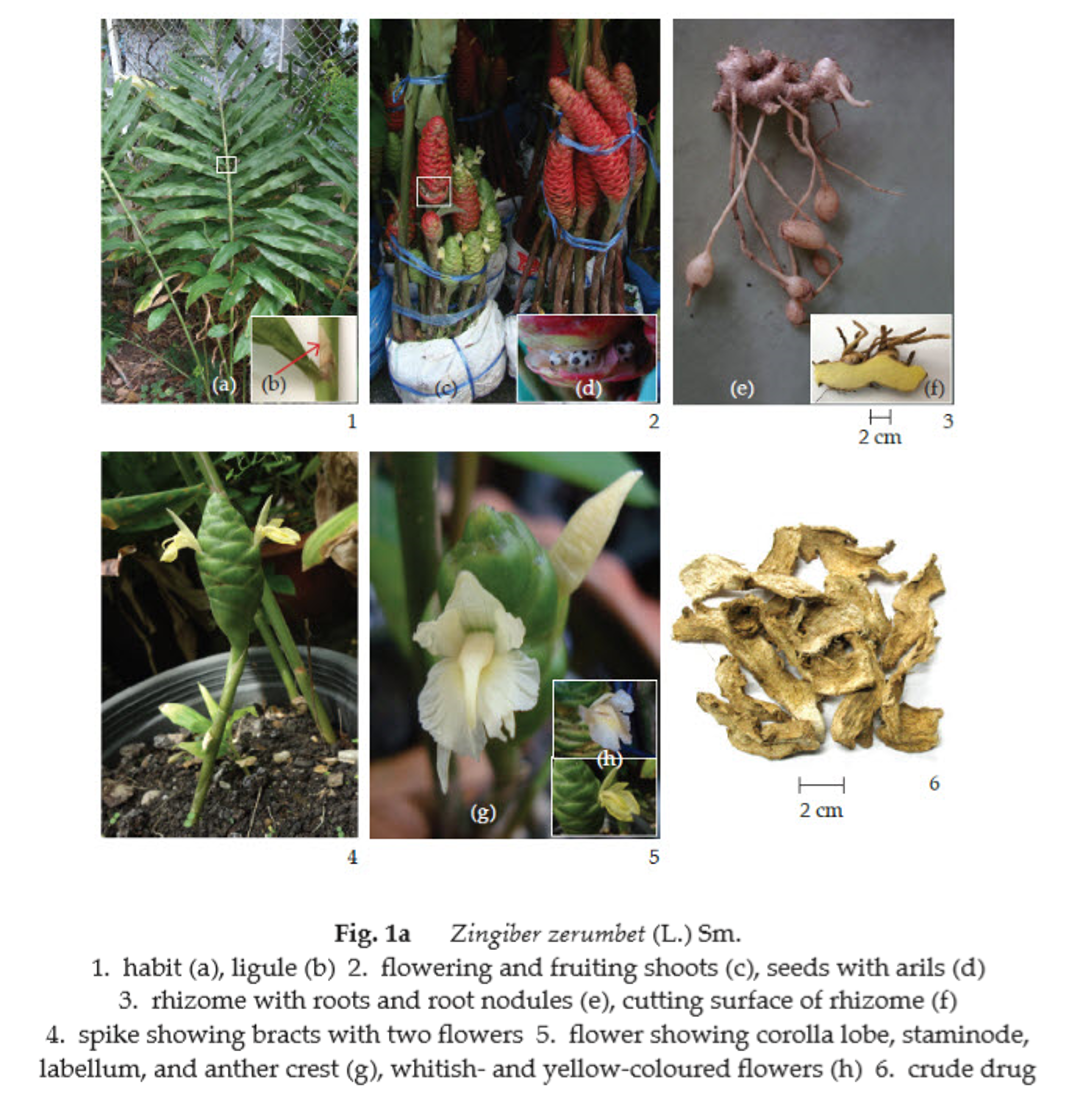
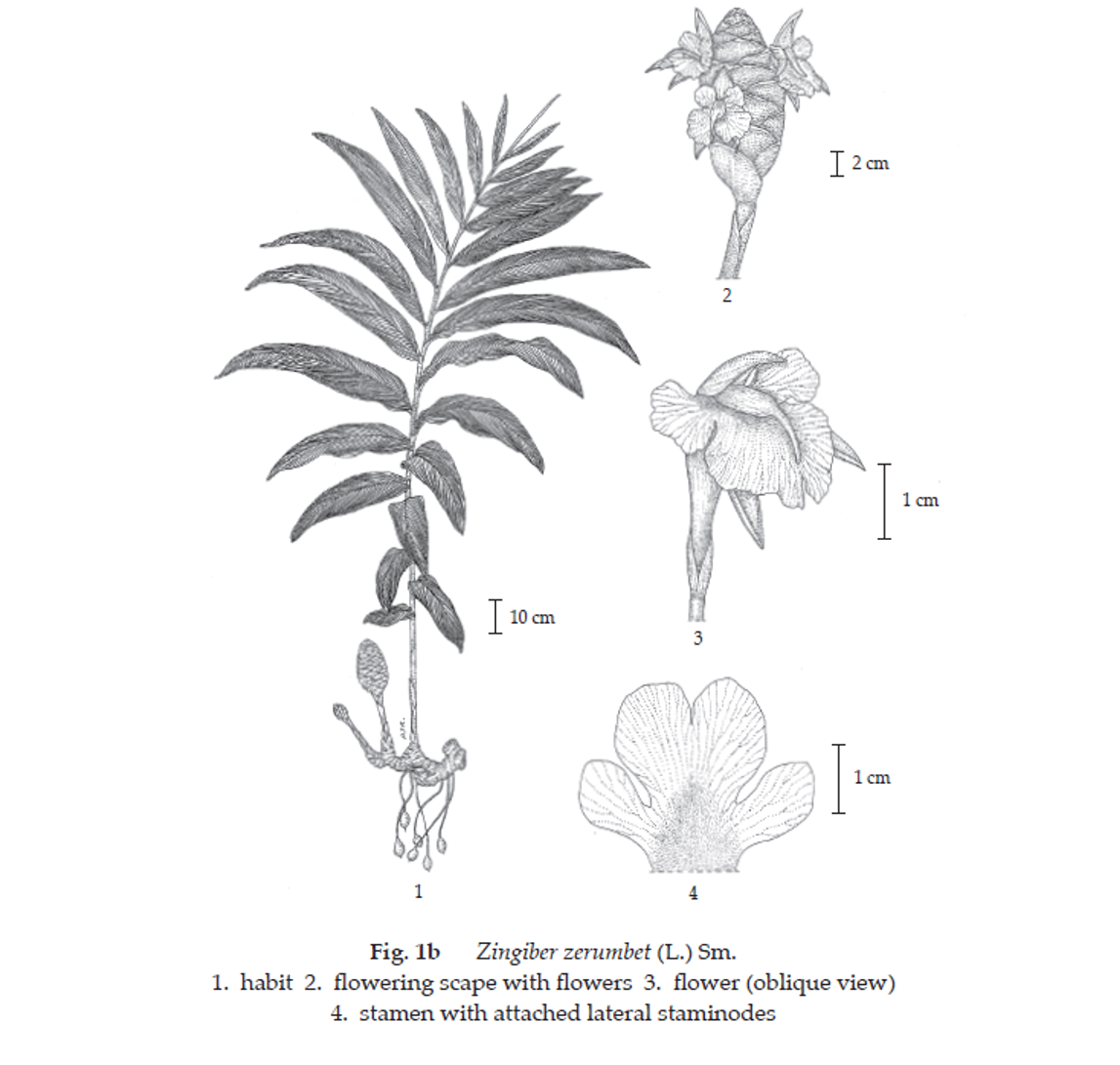
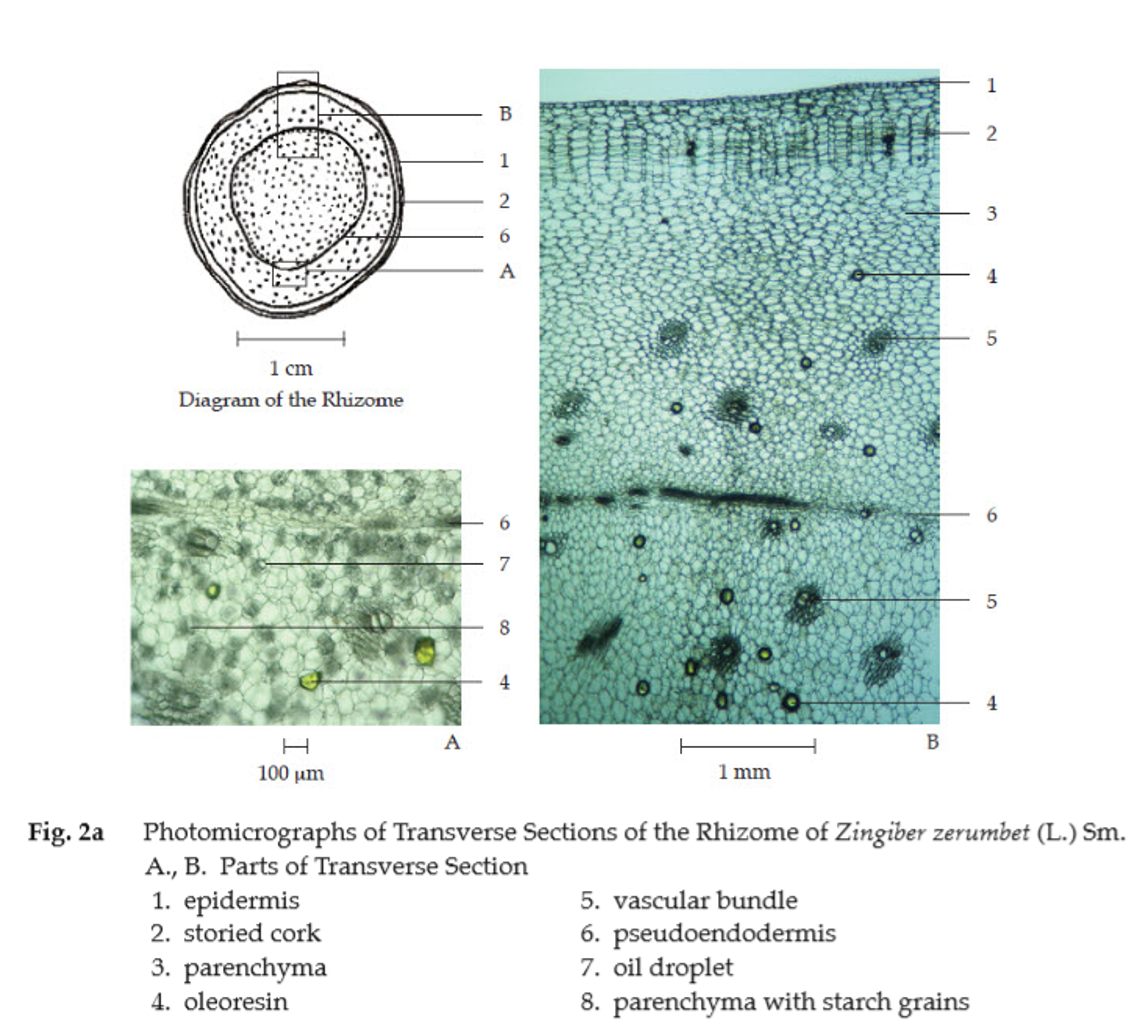
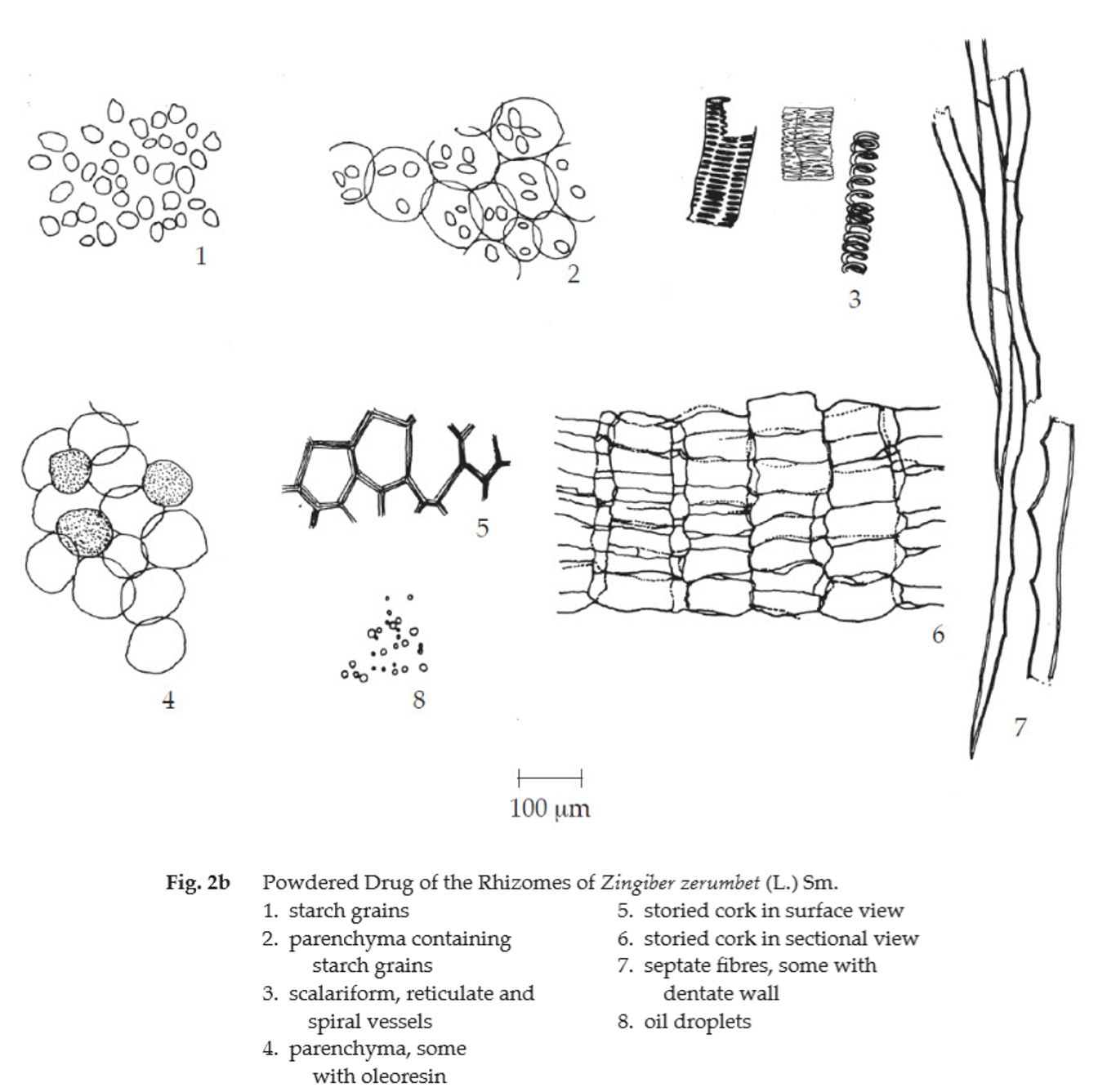
Zerumbet Ginger in powder possesses the diagnostic microscopical characters of the unground drug. Elongate-elliptic, beaked starch grains and scalariform and reticulate vessels are abundant. Oil droplets and oleoresins can also be observed. Septate fibres, some with dentate wall are characteristic.
Additional information The fresh rhizomes are traditionally used as a galactagogue.
Packaging and storage Zerumbet Ginger shall be kept in well-closed containers, preferably of metal or glass, protected from light and stored in a cool and dry place.
Identification
A. Warm 500 mg of the sample, in powder, with 10 mL of water on a water-bath for 15 minutes and filter. To 2 mL of the filtrate, add a few drops of iron(III) chloride TS: a greenish brown colour is produced.
B. Carry out the test as described in the “Thin-Layer Chromatography” (Appendix 3.1), using silica gel GF254 as the coating substance and a mixture of 75 volumes of toluene and 25 volumes of ethyl acetate as the mobile phase. Apply to the plate, 5 μL of the test solution prepared by macerating 1 g of the sample, in No. 250 powder, in 10 mL of methanol for 6 hours, filtering and evaporating the filtrate to dryness. Dissolve the residue in 1 mL of methanol. After removal of the plate, allow it to dry in air and examine under ultraviolet light (254 nm), marking the quenching spots. Subsequently examine the plate under ultraviolet light (366 nm) through the cut-off filter; one yellow and one bluish yellow fluorescent spots are observed. Spray the plate with anisaldehyde TS and heat at 120° for 5 minutes; two pink and three purple spots appear (Table 1); see also Fig. 3.
Table 1 hRf Values of Components in Methanolic Extract of the Rhizomes of Zingiber zerumbet (L.) Roscoe ex Sm.
| Spot | hRf Value | Detection | ||
| UV 254 | UV 366 | Anisaldehyde TS | ||
| 1 2 3 4 5 6 7 8 |
20-24 24-32 35-40 48-54 55-61 57-64 64-73 78-83 |
quenching - - quenching - - strong quenching - |
- yellow - - - bluish yellow - - |
- - purple pink pale pinK - dark purple pale purple |
Water Not more than 11.0 per cent v/w (Azeotropic Distillation Method, Appendix 4.12).
Foreign matter Not more than 1.0 per cent w/w (Appendix 7.2).
Acid-insoluble ash Not more than 5.0 per cent w/w (Appendix 7.6).
Total ash Not more than 10.0 per cent w/w (Appendix 7.7).
Ethanol-soluble extractive Not less than 2.0 per cent w/w (Appendix 7.12).
Water-soluble extractive Not less than 9.0 per cent w/w (Appendix 7.12).
Volatile oil Not less than 0.6 per cent v/w (Appendix 7.3H). Use 50 g, in No. 250 powder, freshly prepared and accurately weighed. Use 300 mL of water as the distillation liquid and a 500-mL round-bottomed flask. Distil at a rate of 2 to 3 mL per minute for 5 hours. Use 2.0 mL of xylene in the graduated tube.
